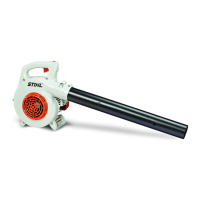BG 55, BG 65, BG 85, SH 55, SH 85
English
4
WARNING
Be particularly alert and cautious when
wearing hearing protection because
your ability to hear warnings (shouts,
alarms, etc.) is restricted.
THE POWER TOOL
For illustrations and definitions of the
power tool parts see the chapter on
"Main Parts."
WARNING
Never modify this power tool in any way.
Only attachments supplied by STIHL or
expressly approved by STIHL for use
with the specific STIHL blower model
are authorized. Although certain
unauthorized attachments are useable
with STIHL power tools, their use may,
in fact, be extremely dangerous.
If this tool is subjected to unusually high
loads for which it was not designed (e.g.
heavy impact or a fall), always check
that it is in good condition before
continuing work. Check in particular that
the fuel system is tight (no leaks) and
that the controls and safety devices are
working properly. Do not continue
operating this machine if it is damaged.
In case of doubt, have it checked by your
STIHL servicing dealer.
WARNING
Small particles (e.g. dust) blown through
the blower tube and nozzle can cause a
static charging of the blower tube. This is
especially true in low humidity and high
dust conditions. In order to reduce the
risk of shock from static charging and
subsequent injury from loss of control,
your blower has features designed to
help reduce the build up of static
electricity in the blower tube and
equalize the charge with the engine and
/ or operator.
The control handle is designed to
conduct static electricity through the
throttle cable to the engine and from the
handle through the operator to the
ground.
THE USE OF THE POWER TOOL
Transporting the Power Tool
WARNING
When transporting your power tool in a
vehicle, properly secure it to prevent
turnover, fuel spillage and damage to
the unit.
Fuel
Your STIHL power tool uses an oil-
gasoline mixture for fuel (see the
chapter on "Fuel" of your instruction
manual).
To reduce the risk of
injury to your eyes never
operate your power tool
unless wearing goggles
or properly fitted protec
-
tive glasses with
adequate top and side
protection complying with
ANSI Z 87.1 (or your
applicable national
standard).
Power tool noise may
damage your hearing.
Wear sound barriers (ear
plugs or ear mufflers) to
protect your hearing.
Continual and regular
users should have their
hearing checked
regularly.
Clothing must be sturdy
and snug-fitting, but allow
complete freedom of
movement.
Avoid loose-fitting jack
-
ets, scarfs, neckties,
jewelry, flared or cuffed
pants, unconfined long
hair or anything that
could become drawn into
the air intake. Secure hair
so it is above shoulder
level.
Good footing is very
important. Do not wear
sandals or go barefoot.

